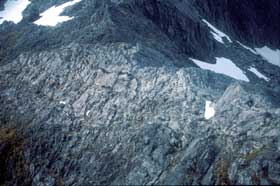Earth Scientists Forge New Understanding of Mountain-Building Dynamics

Photograph showing typical texture indicative of what was once magma within the central parts of a batholith (a large intrusion of magma into rock). <br>Credit: Photo courtesy of Keith Klepeis, University of Vermont; NSF
Understanding how mountains form is critically important — from volcanic eruptions to earthquakes to catastrophic mudslides, the geologic processes active in mountain belts affect human societies every day. Yet, even though mountains are on all continents and in all ocean basins, scientists still understand relatively little about the forces that interact to form and destroy mountains, how mountains change over time, and the relationship between mountains and Earth’s climate.
To better understand these dynamics, earth scientists are now integrating studies across traditional disciplinary boundaries. In research funded by NSF and published in the January 2003 GSA Today, scientists have demonstrated a new way to integrate results from observations collected in the field with laboratory and experimental techniques. The team studied a mountain belt located in Fiordland, South Island, New Zealand.
“This integrative approach has allowed a better understanding of the processes [behind mountain building],” said Tracy Rushmer, a geologist at the University of Vermont and a co-author of the GSA Today paper. The findings have revealed processes that control the movement of magma, the impact of magma on rock deformation, and how the strength of the mountain belt changes through time, said Rushmer.
In Fiordland, where rocks from early mountain-building on Earth are exposed at the surface, the research has, “revealed the mechanisms by which magma was generated and transported through lower continental crust, and how these processes affected the formation of mountains over millions of years,” said Rushmer.
Researchers know that mountains are the surface expression of plate tectonic forces — forces that make our planet different from all others in the solar system. Tectonic forces are the dynamic link between processes active in the deep Earth, processes that change Earth’s surface, and the atmosphere that drives the hydrologic cycle and fosters life. Towering mountain ranges, such as the Himalayas, exist because rock is uplifted so quickly that erosion can not strip it away fast enough to level the peaks. Such an understanding is important, say geologists, because ultimately it will allow us to more accurately predict the Earth’s behavior.
Media Contact
More Information:
http://www.nsf.gov/od/lpa/news/03/tip030123.htmAll latest news from the category: Earth Sciences
Earth Sciences (also referred to as Geosciences), which deals with basic issues surrounding our planet, plays a vital role in the area of energy and raw materials supply.
Earth Sciences comprises subjects such as geology, geography, geological informatics, paleontology, mineralogy, petrography, crystallography, geophysics, geodesy, glaciology, cartography, photogrammetry, meteorology and seismology, early-warning systems, earthquake research and polar research.
Newest articles

Why getting in touch with our ‘gerbil brain’ could help machines listen better
Macquarie University researchers have debunked a 75-year-old theory about how humans determine where sounds are coming from, and it could unlock the secret to creating a next generation of more…

Attosecond core-level spectroscopy reveals real-time molecular dynamics
Chemical reactions are complex mechanisms. Many different dynamical processes are involved, affecting both the electrons and the nucleus of the present atoms. Very often the strongly coupled electron and nuclear…

Free-forming organelles help plants adapt to climate change
Scientists uncover how plants “see” shades of light, temperature. Plants’ ability to sense light and temperature, and their ability to adapt to climate change, hinges on free-forming structures in their…





















